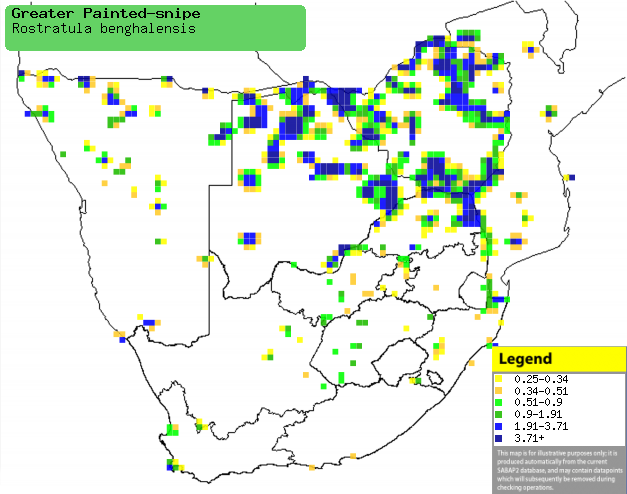|
Rostratula benghalensis (Greater painted-snipe,
Painted snipe)
Goudsnip [Afrikaans]; Goudsnip [Dutch]; Rhynchée
peinte [French]; Goldschnepfe [German]; Narceja-pintada [Portuguese]
Life
> Eukaryotes
>
Opisthokonta
> Metazoa
(animals) > Bilateria > Deuterostomia >
Chordata > Craniata > Vertebrata (vertebrates) > Gnathostomata (jawed
vertebrates) > Teleostomi (teleost fish) > Osteichthyes (bony fish) > Class:
Sarcopterygii (lobe-finned fish) > Stegocephalia (terrestrial vertebrates) >
Tetrapoda (four-legged vertebrates) > Reptiliomorpha > Amniota >
Reptilia
(reptiles) > Romeriida > Diapsida > Archosauromorpha > Archosauria >
Dinosauria (dinosaurs) > Saurischia > Theropoda (bipedal predatory
dinosaurs) > Coelurosauria > Maniraptora > Aves (birds) >
Order: Charadriiformes
> Family: Rostratulidae
Distribution and habitat
Occupies much the Old World, from Australia through Japan
and southern Asia to much of sub-Saharan Africa, largely excluding the lowland
forest of the DRC and West Africa. In southern Africa it is rare to locally
fairly common in Zimbabwe, northern and eastern Botswana, northern Namibia and
isolated patches of Mozambique and South Africa. It generally prefers dams, pans
and marshy river flood plains, or any waterside habitat with mud and vegetation.
|
 |
|
Distribution of Greater painted-snipe in southern
Africa, based on statistical smoothing of the records from first SA Bird
Atlas Project (©
Animal Demography unit, University of
Cape Town; smoothing by Birgit Erni and Francesca Little). Colours range
from dark blue (most common) through to yellow (least common).
See here for the latest distribution
from the SABAP2. |
Movements and migrations
Little known, although it is generally most
abundant in southern Africa in summer, from December-March, while it
is most common in the Sahel in the period from July-August. This
suggests that it migrates north to avoid the dry season.
Food
It mainly eats worms, grasshoppers and crickets (Orthoptera),
crustaceans, snails and seeds, doing most of its foraging by probing the mud in
search of food.
Breeding
- Serially polyandrous, as each female mates with 2-4 males per breeding
season, although only one male at any one time helps with incubation and the
care of the chicks.
- The nest is a slight depression in vegetation, concealed by overhanging
sedges or grasses; it rarely uses a scrape in open mud flats instead.
- Egg-laying season is from about July-April, peaking from
September-March.
- It lays 2-5 eggs, which are incubated solely by the male for about 15-19
days, although the female occasionally helps out.
- The chicks leave the nest about 12 hours after they hatch, sticking
close to the male, who provides them with food for at least the first 10
days (at which point they start to forage for themselves). The male may also
perform distraction displays if a predator approaches. They fledge at about
30-35 days old, remaining with the male for another 1-2 months.
Threats
Probably not threatened, although its Western Cape
population has greatly decreased in size since 1980, and is now thought to
consist of less than 200 individuals. This is thought to have been caused by
development around Cape Town and invasion of flood plains by Bulrushes (Typha
capensis), which is a consequence of dampened seasonal flooding due to
regulated stream flow.
References
-
Hockey PAR, Dean WRJ and Ryan PG 2005. Roberts - Birds of
southern Africa, VIIth ed. The Trustees of the John Voelcker Bird Book
Fund, Cape Town.
|
